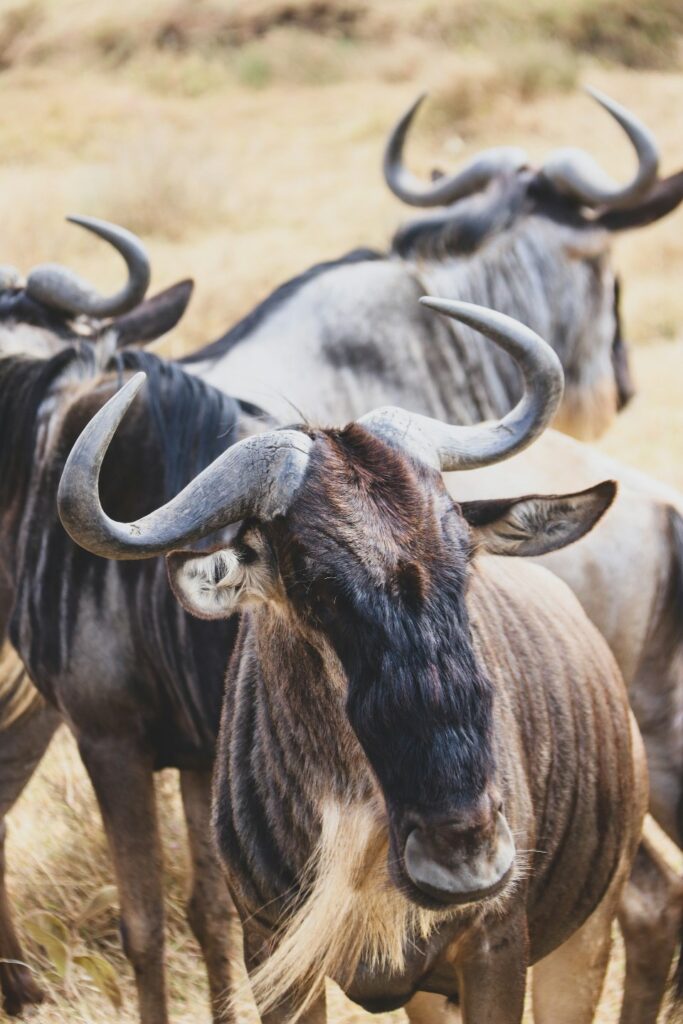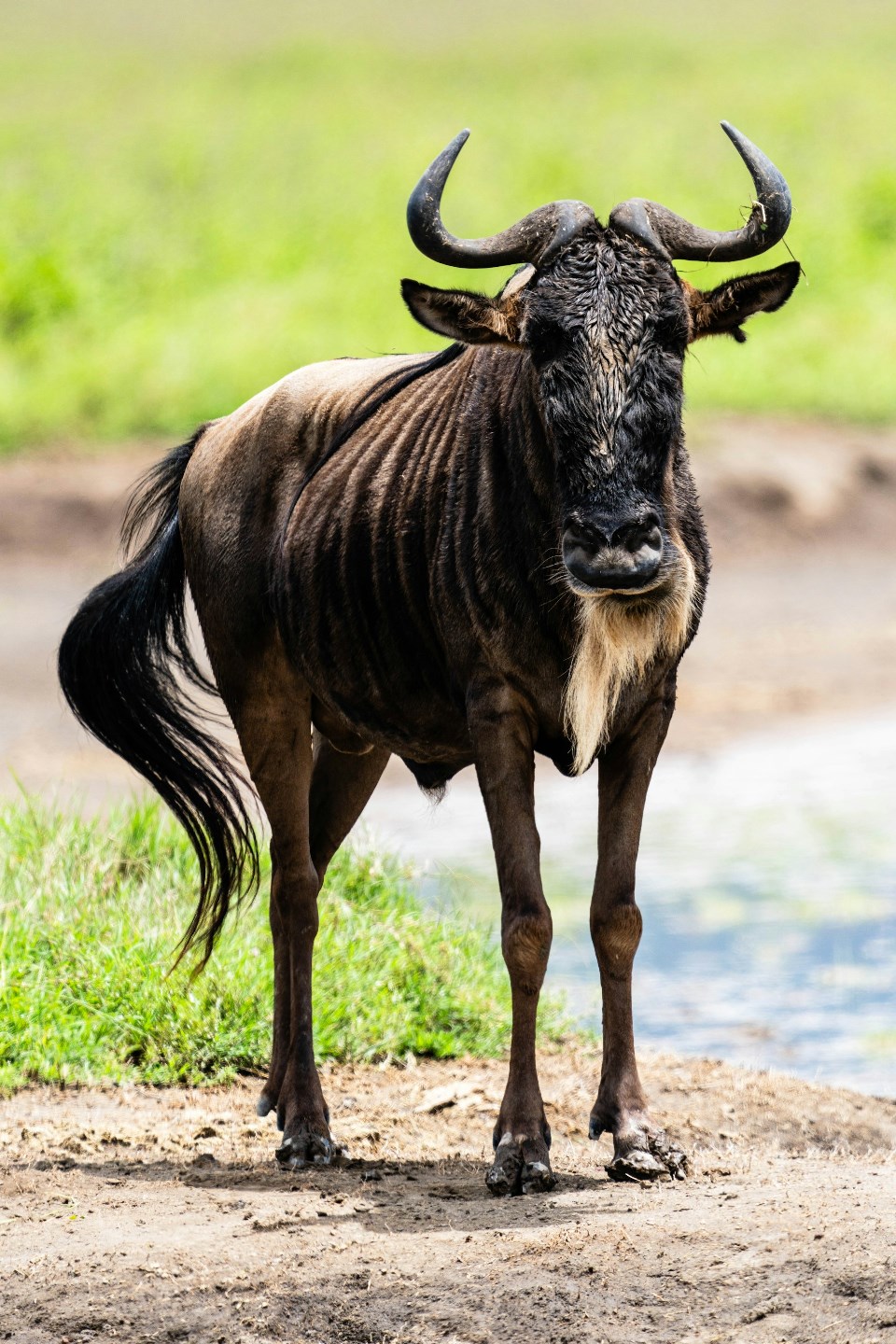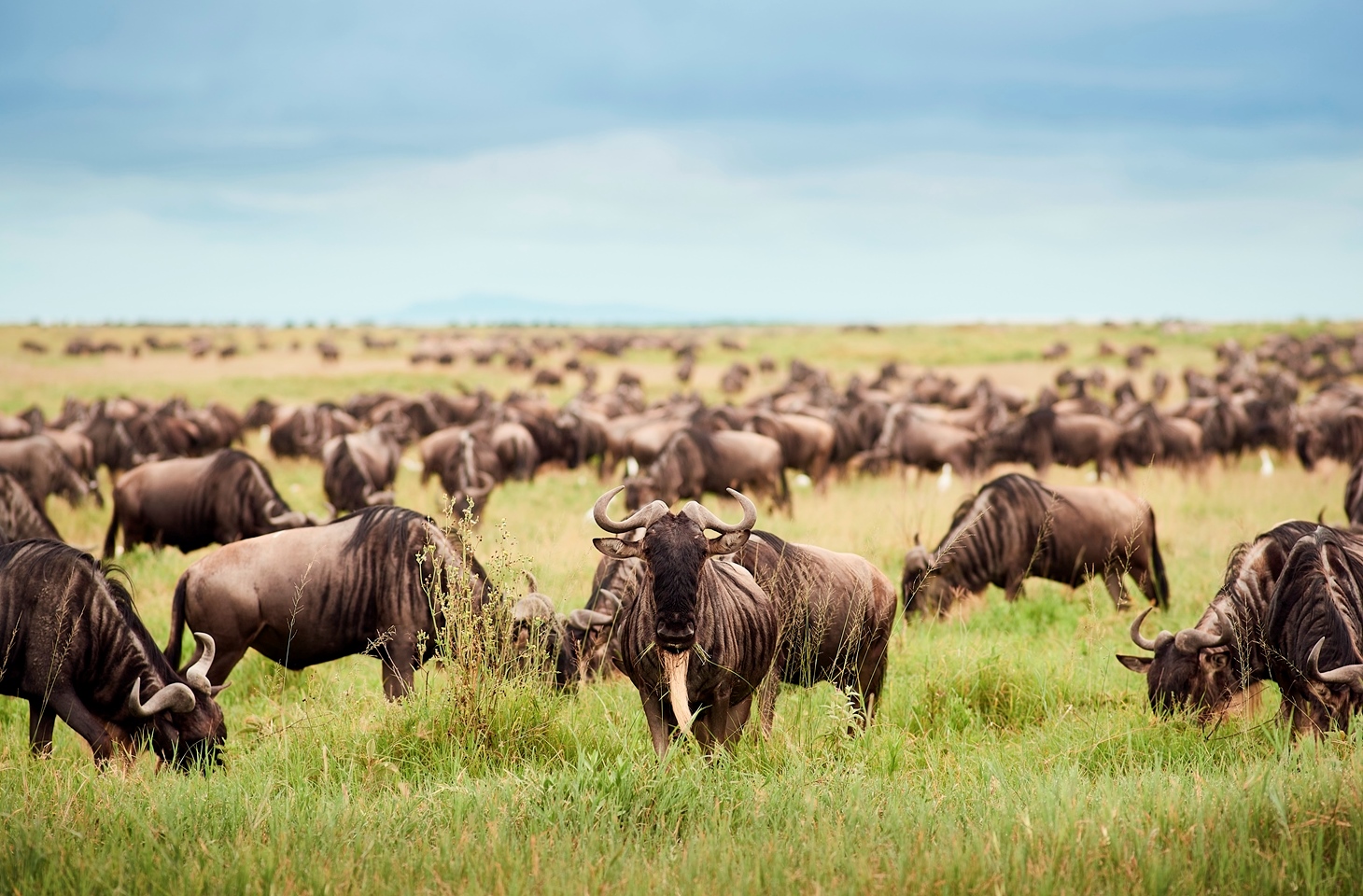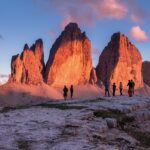Ultra Luxury Journeys in Eastern & Central Africa
The Great Wildebeest Migration
- Maasai Mara National Reserve, Kenya


Best Wildebeest Migration Safari Destinations Guide
The World's Most Spectacular Wildlife Migration...
The Africa’s ecosystems of the Maasai Mara and Serengeti National Park on a rotational basis are home to huge herds of wildebeest and zebras migrating in a continuous search for pasture and water respectively. The migration isn’t new to science as the journey is well known to follow a similar annual route, but the exact timing still baffles many wildlife biologists due to the changing rain patterns.
Annually and continuously, when the rains are scarce, the herds of gnu go. In spite of the big cats waiting on the plains, or the crocodiles that inhabit the rivers and other water bodies on their way, wildebeests still follow their natural radar with humbleness in their never-ending clockwise circular migration trek.
What is the Great Wildebeest Migration?
This is the largest overland migration on Earth bringing wildebeest and zebras that cover 800+ km during each cycle. The magnificence of the event lies in its magnitude at jammed river crossings in the Tanzania’s Serengeti National Park and Kenya’s Maasai Mara National Reserve attracting between 1.5 to 2 million wildebeests, zebras and other wildlife species.
Interestingly for ages, the herds move in a clockwise direction, up from the south of the Serengeti vast plains, through the Ngorongoro Conservation Area, the Loliondo Game Controlled Area, and the Grumeti Reserve. Please read more about the Great Wildebeest Migration in Tanzania. They then leave Tanzania briefly to spend time in Kenya’s Maasai Mara National Reserve, which borders Serengeti National Park to the north. From Kenya, the migration heads back south to start the journey again. Most of the migration takes place in the far larger Serengeti National Park as opposed to the spectacular show that in the Maasai Mara National Reserve between the months of July – October.
The mortality rate of the migrating beasts are it highest during the migration period. It’s estimated that about 2,500 wildebeests and 3,000 zebras perish on a daily basis due to the predation by carnivores, drowning in the fast moving waters, hunger, thirst, and exhaustion.
The migrating herds aren’t only attractive to the cats and crocodiles on the ground, vultures, eagles, crows and other birds of prey get attracted too. Back on the ground human aren’t left behind as they also follow the herds in equal measures to capture the best of the Greatest Show on Earth.
Luxury Safaris Par Excellence
Following the Wildebeest Trails on a Luxury Safari with Oluokos Signature

The wildebeest migration safari isn’t your ordinary Big 5 safari, as nature does keep and follow its own time. In the recent years, even some of the veteran wildlife moviemakers and photographers who have participated in the well-documented river crossings have failed to predict when and where.
Thankfully, it’s the unpredictability of the migration, the expected river crossings reward the ever-patient safari guides, and the seasoned guests on how best how to enjoy the vast savannahs while waiting for the dramatic river crossings and predator actions that can be delayed for hours to days. In this case, good planning and patience are the golden rules.
The weather pattern is key to this natural phenomenon as the rains determines how the event unfolds so many kilometers behind. With the coming of the rains, tracking the herds is not an exact science, but the same general pattern that has been showcased year in year out. Again, note that the rain could delay and this contributes to the outcome of the migration itself.
The Annual Migration Calendar - Where and When...
January - Naabi Hills in the Southern Serengeti.
The first rains in the southern Serengeti plains beckon the herds to the Ndutu area. If you want to find the wildebeest in January, Naabi Hill and Lobo are the places to look. Many females in the herd are heavily pregnant at this point and moving towards greener grasses is of top priority where the births occur.
February - Birth of New Calves...
Every year half a million wildebeest are born on the Serengeti plains, and February is the month with the highest birthing rate, sometimes seeing as many as 8,000 calves born each day.
The abundant new grass makes the area around Lake Masek and Lake Ndutu the ideal place for the wildebeest to give birth. The herd will stay put for a while in the southeast Ndutu area after the calves are born, before heading up north in a clockwise direction.
Calving season means adorable wobbly babies finding their legs – a bonus for predators, who do not play nicely. If you want to see wildebeest just hours old, your best chance is to go out at midday when they typically give birth, to allow the babies the time to gain strength before nightfall.
The Serengeti also boasts a particularly healthy lion population, with over 3,000 lions in the reserve. This is of considerable significance when you realize that these big cats face a bleak future across the African continent.
March - Track the Herds on Mobile Camping...
The mobile camps in the Serengeti provide an up-close and personal experience of the migration. You can find the herds in the Ndutu and Kusini Maswa region, in the southwest of the park. Having the babies in tow means, they move a bit slower. In addition, be prepared for some afternoon rainfall in March.
April - Big Herds on Ndutu Plains...
If you visit in April, you are going to need your rain jacket. The herds amble from the Ndutu region, past the Simba kopje, in the direction of Moru. The herds have now split into large groups, rather than the massive concentrations that stretch as far as the horizon.
Simba kopje is where the lions are at, and it’s worth spending some time lion hunting – in the strictly photographic sense of the word. The wettest part of the day is the evening. The rainfall makes the plains slippery, and vehicles without 4×4 mode will battle to go anywhere.
May - Moru, Mokoma to Lake Magadi...
For those wildlife photographers looking for action shots, set your sights on May in the Serengeti. The ‘long rains’ keep on going throughout the month. And as the calves get bigger and stronger, the distances the herd covers get longer. You’ll most likely find them between Moru and Mokoma, moving towards Lake Magadi
June - Mbalageti Sector...
By June the rains have abated somewhat, and the herds have spread out. The front-runners reach Mbalageti River around this time. While those bringing up the rear could still be as far back as Lake Magadi or in the southernmost corner of the Simiti and Nyamuma Hills. The herds are now often in long lines as they head north.
July - Grumeti Reserve...
July is mating season in the Serengeti. You can find the herds in the Grumeti Reserve, in the west of the Serengeti, and moving past Fort Ikoma. Crossings of the Grumeti River are worth hanging around for, but the Serengeti is vast and relatively under-developed with lodges, so river crossings are harder to find.
Also, the Grumeti River does not have the volume of water that the Mara River has, and the crossings are not as spectacular. The herds graze their way northward, as they move toward the Maasai Mara in Kenya. This is a trans-border event.
August - Northern Serengeti and the Mara River...
Come August and the herds have made their way up to the northern Serengeti, and face their biggest challenge yet: the Mara River. This fast-moving river flows through the Maasai Mara into the Serengeti. And while the gushing murky waters are captivating, they are also possibly responsible for the highest death toll on route, killing many thousands of wildebeest.
Sometimes the herds plunge en masse off steep banks in their desperate attempts to get across the river, or after being spooked by lions, and the fall alone will kill many individuals. Others drown as they are crushed by the sheer volume of panicking wildebeest trying to scramble up the equally steep banks on the other side. Every death means dinner for monitor lizards, crocodiles, birds and fish – such is nature’s bounty.
In addition, amidst the panic, the dust and the noise, the big cats and hyenas pick off the stragglers and the injured. Be warned that aside from the massive herds, the river crossings also attract large volumes of tourists, who congregate at strategic points to witness this spectacle.
September - Late Mara River Crossings...
The first rains in the southern Serengeti plains beckon the herds to the Ndutu area. If you want to find the wildebeest in January, Naabi Hill and Lobo are the places to look. Many females in the herd are heavily pregnant at this point and moving towards greener grasses is of top priority where the births occur.
October - Being on the Wildebeest Trails...
October offers a scene of casual grazing in the Maasai Mara. The push is over, and the fresh grass is the reward. For the survivors, that is. With the guests traffic now reduced, you can enjoy the Maasai Mara in a more relaxed pace.
November - Tanzania is Calling...
What is known as ‘the short rains’ begin in November, triggering another move, as the herds leave Kenya and south to western Loliondo and the Lobo area in Serengeti National Park. Whether it rains in November or not, is nature’s call. But pack some extra jerseys for the cooler weather. At this point, the herds organize themselves into smaller family groups and get on with the serious business of grazing.
December - Back to Tanzania to Begin the Same...
In December, the migration continues moving south toward the short-grass plains of Ndutu in the Ngorongoro Conservation Area. Some herds can be spotted in the central and eastern Serengeti as they move south, while early arrivals can be found already in Ndutu feasting on fresh grasses.
This is a nice time to see large herds thundering across the plains and beginning to gather in the south. The ever-present resident animals, famous lion prides, and elephant of Kenya’s Maasai Mara provide an excellent combination with the migration herds on the southern Serengeti plains
About the Wildebeest Migration & River Crossings
When people say they’ve come to see the migration, they really mean they have come to see the river crossings. Watching the wildebeest hurl themselves into the water from some jaw-dropping steep riverbanks, one after the other, in a flurry of panic, sends a surge of adrenaline through the most seasoned guests.
Many guests have only watched at the river crossings scenes on Planet Earth – the chaotic clamber of wildebeests, zebras and a few antelope species across turbulent crocodile-infested waters of the Mara River. For the successful ones, the hyenas, lions and leopards lurk amongst the riverine bushes to ambush unsuspecting victims of which a good number succumb to these abled cats. Please, read more about the River Crossings
Learn About The wildebeest migration
Top 8 Wildebeest Migration Safari Tips – Popularly known as ‘the greatest show on earth’, the phenomenon wildebeest migration sees mega herds of almost two million wildebeest, alongside the common zebras and gazelles continuously traveling for thousands of kilometers in a broadly clockwise direction from the southern Serengeti plains in Tanzania, north into Kenya’s Maasai Mara, and back again.





Why Book Your Wildebeest Migration Luxury Safari
With Oluokos,
Our guests tend to ask what the perfect Wildebeest Migration Luxury Safari itinerary looks like and to be honest, we don’t have a straight-forward answer.
To answer you in brief, each guest has a unique taste when it comes to enquiring about the wildebeest migration safari and this could be based on personality that’s strongly influenced by expectations. We have given a few good to check itineraries to serve as wildlife migration inspirations.
We don’t offer Wildebeest Migration Safari as a bucket list destination, but a rich wildlife safari experience with diversity, meaningful purpose to travel, cultural mosaic and of course, unmatched habitats that have given room to wildlife migration.
To many, The Great Wildebeest Migration is a living testimony about nature’s resilience, majesty and sustainability. This annual journey, undertaken by over two million wildebeest, zebras, and antelope across the vast plains of Kenya and Tanzania, is a spectacle that captivates guests from all walks of lives. Let Oluokos Signature bring you closer to the ever-unfolding natural spectacle with an exclusive, front-row seat to one of nature’s greatest shows on Earth.
Our African Luxury Trips
Top 10 Best Wildebeest Migration Luxury Safaris By Oluokos
At Oluokos Signature, we recognise that each guest is unique. That’s why our Great Wildebeest Migration Luxury Safari itineraries are carefully tailored to meet your wide taste of an African custom luxury safari.
We factor in the timing of your safari, highlights you wish to see, level of luxury safari adventure you’re comfortable with, and kind of accommodation that suits your preferance.
Whether you’re eager to capture the dramatic river crossings on camera or wish to witness the spectacle from a hot air balloon, Oluokos African custom luxury travel experts will help craft the perfect itinerary for you and your loved ones.
At Oluokos, creating effortless African holiday experiences is our cup of coffee! In Africa, our luxury safaris are packed with transformative moments that resonate deeply with you, fulfilling your holiday dreams and ideals.
"Can Definately Recommend"

Lea K from Denmark
"Amazing!"

Nia Gibson from United Kingdom
"Birding With Oluokos"

Nathan M from USA
"Great Experience at Ruma National Park"

Sarah G from USA
"Once In Lifetime"

Charlotte from United Kingdom
"Best Birding Guide"

Valerie M from USA
"Not Your Regular Safari/Tour Guide.... So Much More!"

Kelly B from USA
Discover Your Next Adventure with
Contact Our Luxury Travel Expert
Our Photos' Credit
- Adarsh Nagda
- Doc. Victor Ikawa
- Laure Dupont Benjamin
- Steve Methu
- Oystein Storkesen
What Our Clients Say About Us
Explore More
{Oluokos Signature}
Typically replies within minutes
Any questions related to African luxury custom safari? #GoBetterWithOluokos! Please, share with us your African custom luxury safari requirement and our luxury safari designers will be delighted to assist you.
WhatsApp Us
Online | Privacy policy






